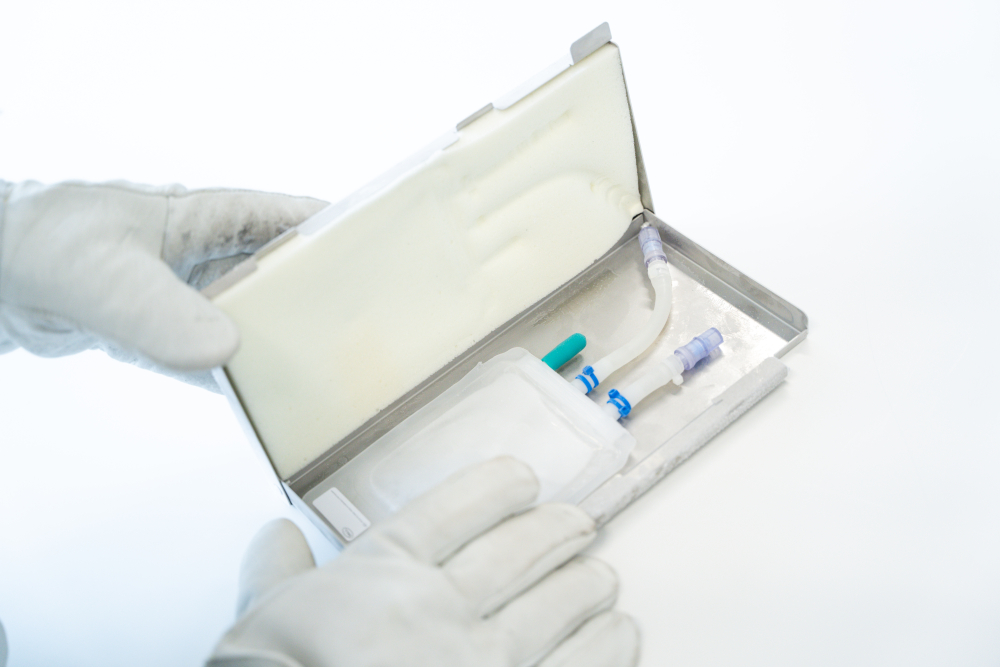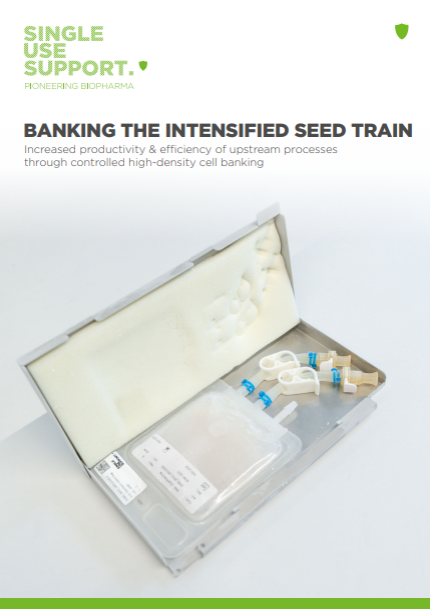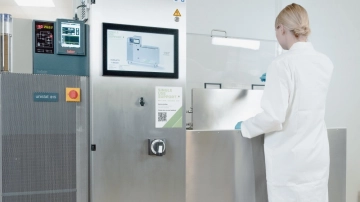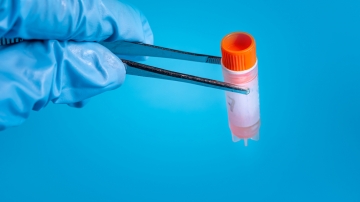Interview: Efficient Cell Banking in Seed Train Intensification
Table of contents
ShowKhalil Essani, Product Line Manager at Single Use Support, is an expert in bioprocessing applications for single-use technologies. He provides valuable insights, advantages and solutions using cell banking in seed train intensification in the following exclusive interview.
In general, what is the rationale behind seed train intensification?
Essani: For all approved biological therapies, about 90% are produced in CHO cells. In contrast to simple protein expression systems like bacteria (E. coli) and yeast (S. cerevisiae, Pichia Pastoris), mammalian expression systems as CHOs have a much longer generation time (E. coli: 20min-1 S. cereviae, Pichia pastoris 40min -120min-1, CHO cells: 18-24h), a higher demand of oxygen and require a more complex medium, making the expansion process time and resource intensive.
CHO cells as expression system for mAbs production is traditionally performed in batch mode and starts with a small cryovial (1-5ml) that is applied to inoculate a small cultivation volume (50-500ml). After the cells have multiplied in the smaller volume to reach a certain concentration, the culture can be used to inoculate the next larger cultivation. This subsequent expansion steps can include multiple flasks and reactors of different sizes and might last for 20-30 days, before the final inoculation of the production reactor can start.
Utilizing high-density (HD) cell banking presents an effective strategy to reduce the number of seed train steps and enhance operational efficiency. This approach involves cultivating cells to a high density in a fed-batch or perfusion bioreactor, followed by aliquoting and cryopreserving the HD cell culture in multiple single-use cryobags. Subsequently, for each manufacturing campaign run, cells are thawed from one or more cryobags and directly inoculated into the N-2, or even N-1 bioreactor.
The main motivation for seed train intensification in upstream development is to decrease manufacturing timelines and reduce cost of goods, facility space and contamination risk while increasing process consistency as well as space and time yield.

The main motivation for seed train intensification in upstream development is to decrease manufacturing timelines and reduce cost of goods, facility space and contamination risk while increasing process consistency as well as space and time yield.
Khalil EssaniWhy is seed train intensification such a thing in Biopharma?
Essani: The current emphasis in biopharmaceutical research and production of mAbs has shifted from optimizing cell lines and media to intensifying production processes, aiming to realize time and cost efficiencies. For example, the construction of traditional stainless-steel facilities are time, space and resource intensive, and therefore have to start at an early stage (clinical phase 2) during drug development. At this early stage, approval is not guaranteed (probability of approval: 15%), but at the same time large upfront investments are required. The construction of single-use facilities for process intensification is less complex and thereby may start in clinical phase III (probability of approval: 50%). Investing in facilities and equipment during a later clinical phase reduces investment risk for stakeholders.
For approval of mAb-based biosimilars, the manufacturing process must prove that the monoclonal antibody behaves like the originator. Thereby a robust and consistent process is critical and strongly impacts product quality criteria. Having fewer expansion steps within the seed train and applying a closed single used system reduces handling and cross contamination risks. The closed single-use system-based process-intensification enables the manufacture to react flexible on product demands, i.e. it allows to produce immunoglobine G (IgG) or other monoclonal antibodies in the same single-use facility and only requires the exchange of single-use consumables.
Why should one bank cells in a cryobag during cell culturing?
Essani: In a traditional culture expansion scenario, the maximum cell concentration achieved in the pre-cultures determines the split ratio and requires the use of multiple bioreactors in the seed train. As a rule, sequential expansion phases with split ratios of 1:5 to 1:10 are used. In other words, a certain start (inoculation) cell concentration is required to cultivate the cells and efficiently achieve the exponential growth phase.
Reducing the seed train time is a key part of optimizing and intensifying processes. Starting with a larger initial cell mass cuts down the time needed to build up enough biomass for seeding an N-stage bioreactor. There are essentially two ways to do this: Either increase the volume of the initial inoculum or raise its concentration.
Having a high cell density culture bank readily available circumvents the multiple expansion steps thereby potentially reducing process time by one third to half. Instead of having to start from a small cryovial each time, manufactures can directly access the high cell density culture from the banked single-use cryo-bag. Therefore, the expansion in theory needs to start only once from the working cell bank cryovial. Reducing these cumbersome pre culturing expansion steps, not only saves time and costs, but also reduces the risk of potential contamination. Furthermore, upstream process steps lacking active pH and dissolved oxygen control are removed, ensuring cells receive consistently stable conditions. Furthermore, it saves equipment and consequently footprint required, for example when thawing a cryobag goes directly to larger volumes without the need of waves, flasks, etc.

Why is scalability such a challenge?
Essani: N−1 perfusion, in which perfusion cultivation is done as the final step of inoculum production to generate UHCD-WCBs (ultra-high cell density working cell banks) exceeding 100 × 106 cells mL−1. These cells can subsequently be used to inoculate a production bioreactor.
Fed-batch processes have been established from lab to commercial scales up to 25,000L, Usually the volume of a stirred tank production reactor exceeds 15,000L, with an inoculation concentration of 0.2-1 x 106 cells/ml. To inoculate a production reactor of 15,000L at a required cell density of 0.5 x 106 cells/ml, 7.5 x 1012 cells are required for inoculation. Assuming that a N-1 perfusion reactor is able to generate cell density of 100 × 106 cells mL−1, 7.5 x 104 ml (75L) of a HCD culture would be needed for inoculation. Aliquoting such a large volume and controlled freezing to guarantee cell recovery of this volume is out of feasibility. This extreme example should illustrate the limitations in scaling-up the high cell density cryopreservation (HCDC) process for seed train intensification
Therefore, the most practical approach is that the high cell density culture is applied for the inoculation of a N-1 perfusion reactor of about 50-200L.
To inoculate such a N-1 perfusion reactor with a working volume of 50L, a cryobag with a culture volume of 250 ml (with 100 x 106 cells per ml) can be applied. A culture volume of 250mL enables fast aliquotation in cryobags. Cryobags that can handle such a volume are available and validated to restrain the very low freezing temperatures when filled. Smaller volume of single-use cell cryobags (100ml-1000ml) also allow a more controlled freezing process than a very large single-use container would do. During cryopreservation, controlled freezing is highly central for achieving critical quality attributes, which are reproducible cell recovery rates, viable cell density (VDC) and cell viability post-thaw, as already small deviations from the optimal freezing rate will impact viability.
What other challenges do you see in this matter?
Essani: An optimized cryopreservation process must be developed for each cultivation scenario. This starts by using a suitable cryoprotectant, finding the optimal freezing and thaw rate, tightly control the time for phase transition - as it might have the biggest impact on cell viability. In case a cytotoxic CPA is applied, the incubation time of the cells and the CPA needs to be optimized, meaning it should be long enough to allow to diffuse inside the cell and short enough to prevent toxic effects. CPA like DMSO show higher cytotoxicity at ambient temperature, thereby the temperature of the cells and the container when the CPA is added is also critical. Another important consideration to develop a robust cryopreservation process, are the selection of the biochemical assays that measure cell recovery and their detailed validation in order to know the assays sensitivity/specificity.
What are the trends in cell banking for seed train intensification?
Essani: Over the past century, there has been a noticeable shift from using bottles and vials to employing single-use cryobags. These cryobags offer advantages such as enabling more controlled freezing and accommodating larger volumes, facilitating high cell density inoculation. Looking ahead, we anticipate a rise in automation for cell banking processes and reducing human intervention within clean rooms. Additionally, there will be advancements in the development of cryopreservation agents that are both less toxic and highly effective. Furthermore, technologies aimed at increasing cell densities, such as sophisticated perfusion systems or specialized reactor designs, are expected to emerge in the coming years.

We anticipate a rise in automation for cell banking processes and reducing human intervention within clean rooms.
Khalil EssaniAs process intensification persists and continuous processing with single-use systems (SUS) becomes more prevalent, the footprint of facilities and their ecological impact are shrinking. This trend is driven by the reduction in raw material usage due to the generation of more product, and faster processing times leading to decreased reliance on facility utilities, thereby lowering fossil fuel consumption.
I am confident that the next major trend in bioprocessing will be fuelled by the imperative for sustainability. Specifically, we may see the emergence of biobased single-use materials that can withstand low temperatures while meeting stringent Good Manufacturing Practice (GMP) standards. Take, for instance, the development of bio-based polyethylene (PE) sourced from sugar cane, presenting a range of grades suitable for HDPE, LLDPE, and LDPE variations.
Investigations have been conducted to assess the environmental impact of bio-based materials in contrast to their conventional counterparts, demonstrating a reduction in both primary energy usage and greenhouse gas emissions. Additionally, there is potential for advancements in cryopreservation technologies, enabling the storage of cells at elevated temperatures compared to conventional methods reliant on liquid nitrogen (LN2) tanks. Looking ahead, it's conceivable that waste heat generated by freezer units could be repurposed as process heat to power bioreactors, representing a novel approach towards energy efficiency in bioprocessing.
Cryopreservation solutions for high cell recovery

Download Whitepaper
Download: Cell Banking for Seed Train Intensification
Cell Banking is a crucial step in the seed train intensification process for biopharmaceutical production. To get the train rolling, multiple optimized process units, that enable high cell densities cultivation & efficient high cell density cryopreservation, need to be combined.












